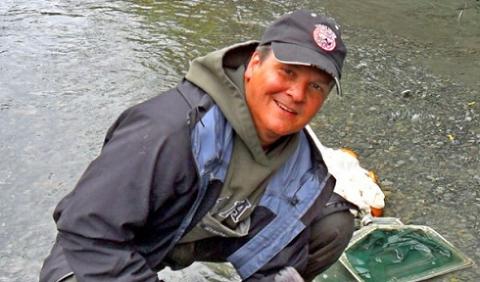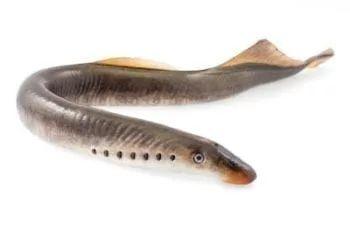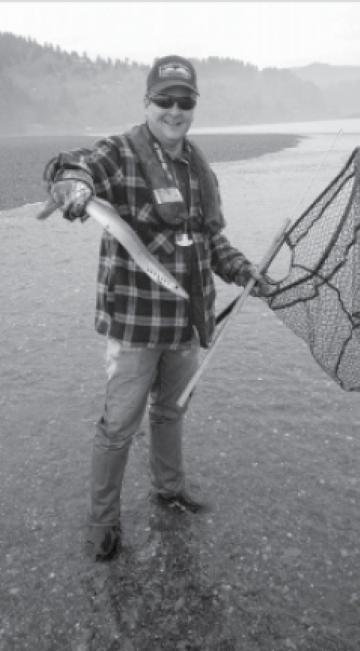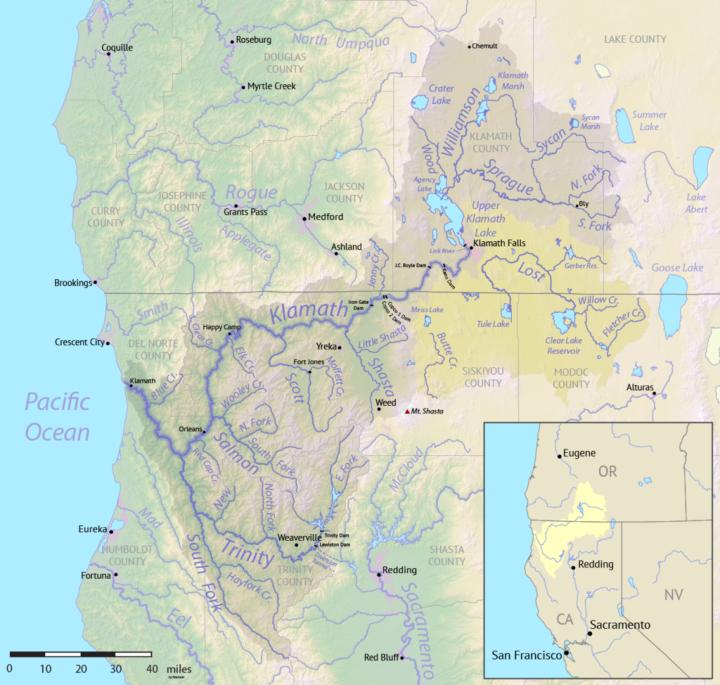 |
Canku Ota
|
 |
|
(Many Paths)
|
||
|
An Online Newsletter
Celebrating Native America
|
||
|
August 2020 - Volume
18 Number 8
|
||
|
|
||
|
Yurok Scientist Verifies
New Subspecies
|
||
|
by Yurok Today
|
||
|
Cutting-edge technology used to identify differences in lamprey DNA In February, Keith Parker's groundbreaking genetic research on the Klamath River's Pacific lamprey was submitted for publication in a prestigious scientific journal.
Parker, a Yurok citizen and fisheries/molecular biologist for the Yurok Fisheries Department, is responsible for identifying a previously unverified, genetically distinct lamprey subspecies on the Klamath. As the lead author, Parker detailed his landmark finding in "Evidence for the Genetic Basis and Epistatic Interactions Underlying Ocean- and River-Maturing Ecotypes of Pacific Lamprey (Entosphenus tridentatus) Returning to the Klamath River, California." The technical manuscript will soon be printed in Molecular Ecology, an internationally acclaimed periodical. "The objective of this study was to employ a combination of currently available technology and our Tribal ecological knowledge in the evaluation of imperiled Pacific lamprey stocks, which are invaluable to Yurok people," Parker said. "I would like to express my sincere appreciation to my collaborators, Dr. Andrew Kinzinger, Dr. John Hess and Dr. Shawn Narum, who are among the best fish geneticists in the country. I would like to thank the Columbia River Intertribal Fish Commission, the National Science Foundation, and The Switzer Foundation for funding this undertaking to improve our understanding of the Klamath River lamprey." Parker co-authored a second technical manuscript on lamprey that was also submitted for publication this month. It is titled "The marine biology of Pacific lamprey (Entosphenus tridentatus)." The paper will be printed in Reviews in Fish Biology and Fisheries, a "quarterly international journal which publishes review articles on varied aspects of fish and fisheries biology." "From a literature review, we synthesized information on the following: freshwater/marine transitions, distribution and movements, feeding behavior and ecology, genetic population structure, predators, recruitment and growth rates, life-history diversity, and limiting factors and threats of Pacific lamprey," Parker said. "We conclude that the characteristics of Pacific lamprey in the ocean makes them a candidate sentinel species for ecosystem health because they are widespread, parasitic and have diverse prey." As illuminated in the Molecular Ecology article, the focus of this Yurok Today story, Parker utilized a cutting-edge technological implement called GT-seq genetic sequencing to identify key differences in each lamprey subspecies' DNA. It was previously thought that two anadromous lamprey varieties could have possibly resided in the Klamath River, but Parker was the first to produce empirical evidence from hundreds of DNA samples verifying the existence of two genetically distinctive lamprey runs — one that enters the river ready to reproduce and another that resides in fresh water for many months before spawning. As the person responsible for this remarkable revelation, Parker was offered an opportunity to name both types. In future scientific literature, the marine-maturing subspecies will be referred to as Tewol, the Yurok term for ocean. He entitled the river-maturing version key'ween, the Yurok moniker for lamprey, which are also called eels. "I thought it was incredibly important for the lamprey to have Yurok names because of our unique connection to these amazing fish," Parker said. The Yurok scientist started his year-long study by collecting a broad set of biological data and genetic samples from 219 lamprey. Early on in the ambitious endeavor he uncovered the first clue that there is more than one lamprey variant in the Klamath.
"The Pacific lamprey I sampled were all over the board in terms
of the relationship between body size and maturity. For example,
one of the smallest egg masses was 1.6 grams and it came from one
of the largest fish. The largest egg mass was approximately 25 grams
or 15 times bigger than the smallest one and it was from a slightly
below average sized fish," Parker said. "This is not typical. For
example, when spring salmon enter the river all of their eggs are
immature and won't fully develop until the fall. When the fall fish
come in we see much more mature eggs. I realized pretty quickly
that we might have two maturation types that are running concurrently.
That is when it started to get really interesting." After the conclusion of the data gathering part of the effort, Parker took lamprey fin clips and tissue samples to the Columbia River Intertribal Fish Commission's laboratory in Hagerman, Idaho. The lab invited him to use its next-generation genetic sequencing machine to genotype all of the specimens. In general, genotyping can be used to perform genetic mapping and detect genetic differences, which is what Parker accomplished. "Once we did that we had a bunch of gene locations jump off the
page for maturation. It was a huge 'ah ha' experience," he said.
"We quickly recognized that we had these two subspecies of Pacific
lamprey. Not only did we know that they were genetically different,
but we could see where their genetic compositions diverged. We From there, Parker decided to delve even deeper into the genetic data, while comparing it to the information he compiled on the lampreys' physical characteristic and lifecycle. Elegantly articulated in his soon-to-be published paper are additional interesting details related to the lamprey subspecies. According to the systematic report, the ocean-maturing strain typically spawns within weeks of entering the river. The river-maturing fish stay in the river for about a year and shrink up to 30 percent before procreating, living off of lipid reserves. "The ocean-maturing types coming in right now are spawning with each other, and they are also spawning with the river types that came in last year," Parker said. "It's nature's way of ensuring extreme genetic diversity by mixing the gene pool between years."
Parker's investigation also illustrates the vast differences between lamprey and the other anadromous fish that inhabit the Klamath, such as chinook salmon. In the limited quantity of peerreviewed studies on lamprey, the species is often erroneously compared to salmon. However, aside from anadromy and expiring after spawning, lamprey and salmon share very little in common. "So much of the literatures says 'similar to salmonids,' 'similar to steelhead,' but what we know now and what I suspected is they vary greatly. We can't study them in the same way," Parker said. One of the most remarkable differences between salmon and lamprey is the fact that the latter is not limited to spawning in its birth stream. "If a Klamath-born lamprey latches on to a migrating gray whale heading to Alaska, it may elect to detach and head up one of rivers in Oregon or Washington to spawn," Parker said. "The ability to spawn in places other than their natal streams is another factor that deepens the gene pool." On the Klamath River, the spawning migration of the two lamprey groups overlap, but the ocean-maturing run is significantly shorter. The ocean set enters the river for only six to eight weeks in the wintertime. The river-maturing variety arrives around February and continues to trickle in until summer. The progeny of the river-developing variant can be either type. However, two ocean-maturing adults are incapable of producing the river form because of their genetic makeup, which poses an opportunity in terms of prudent harvest management. "As the caretakers of the Klamath, we can use genetics to determine when each ecotype is running, so we don't over fish the rare type. If you take them out of the equation it could be catastrophic because they may not be able to be reintroduced," Parker said. Lamprey have one of the most complex lifecycles of any creature on the planet. Even though fish has survived longer than almost every other species on earth, it is substantially understudied. The fish's superior genetic diversity has enabled the lamprey to exist in its current form for a half a billion years. To put that in perspective — dinosaurs came and went while the lamprey persisted. To the Yurok people, lamprey are invaluable in terms of food security and the preservation of vital cultural traditions. Tribal people from Alaska to Southern California consider lamprey a prized resource, but the fish has no recreational or commercial value, which is why it is one of the least understood species when it comes to western science. As a source of sustenance for mammals, birds and other fish, the eel-shaped lamprey has an immense ecological value. It also helps drive marine nutrients from the sea to the forest. The minimal amount of existing research and the species' cultural value are what initially inspired Parker to perform the study. The National Science Foundation and The Switzer Foundation, impressed with his knack for genetic research, awarded him tens of thousands of dollars to conduct the in-depth inquiry and pay for his graduate degree at HSU. Parker, a traditional fisherman, has dedicated his life to studying fish and protecting the Klamath River. "A lot of the lamprey life history isn't known, especially in the ocean," Parker said. "That is why we need to continue expanding our knowledge about this culturally important species." *All of eels used in the study were donated to elders or eaten by local people. |
|||||
|
|
|
||
|
|
||
| Canku Ota is a free Newsletter celebrating Native America, its traditions and accomplishments . We do not provide subscriber or visitor names to anyone. Some articles presented in Canku Ota may contain copyright material. We have received appropriate permissions for republishing any articles. Material appearing here is distributed without profit or monetary gain to those who have expressed an interest. This is in accordance with Title 17 U.S.C. Section 107. | ||
|
Canku Ota is a copyright ©
2000 - 2020 of Vicki Williams Barry and Paul Barry.
|
||
 |
 |
|
|
The "Canku
Ota - A Newsletter Celebrating Native America" web site and
its design is the
|
||
|
Copyright ©
1999 - 2020 of Paul C. Barry.
|
||
|
All Rights Reserved.
|
||



